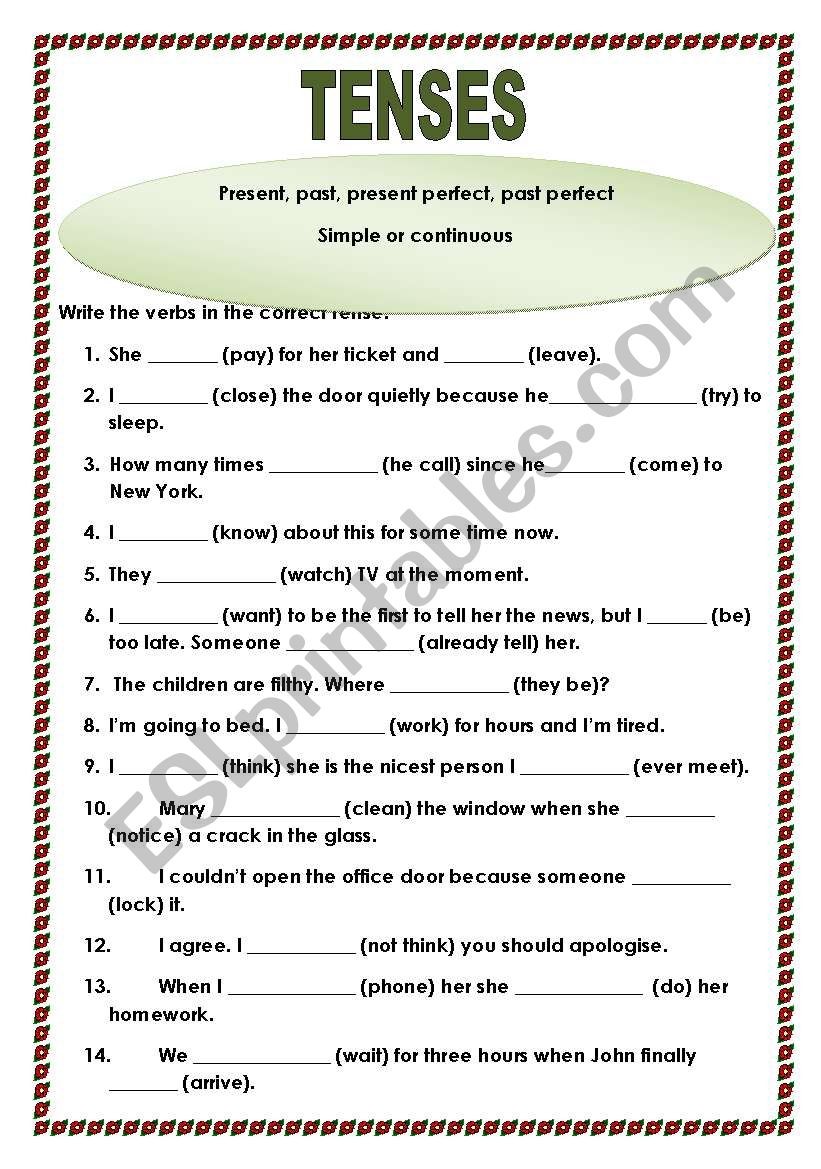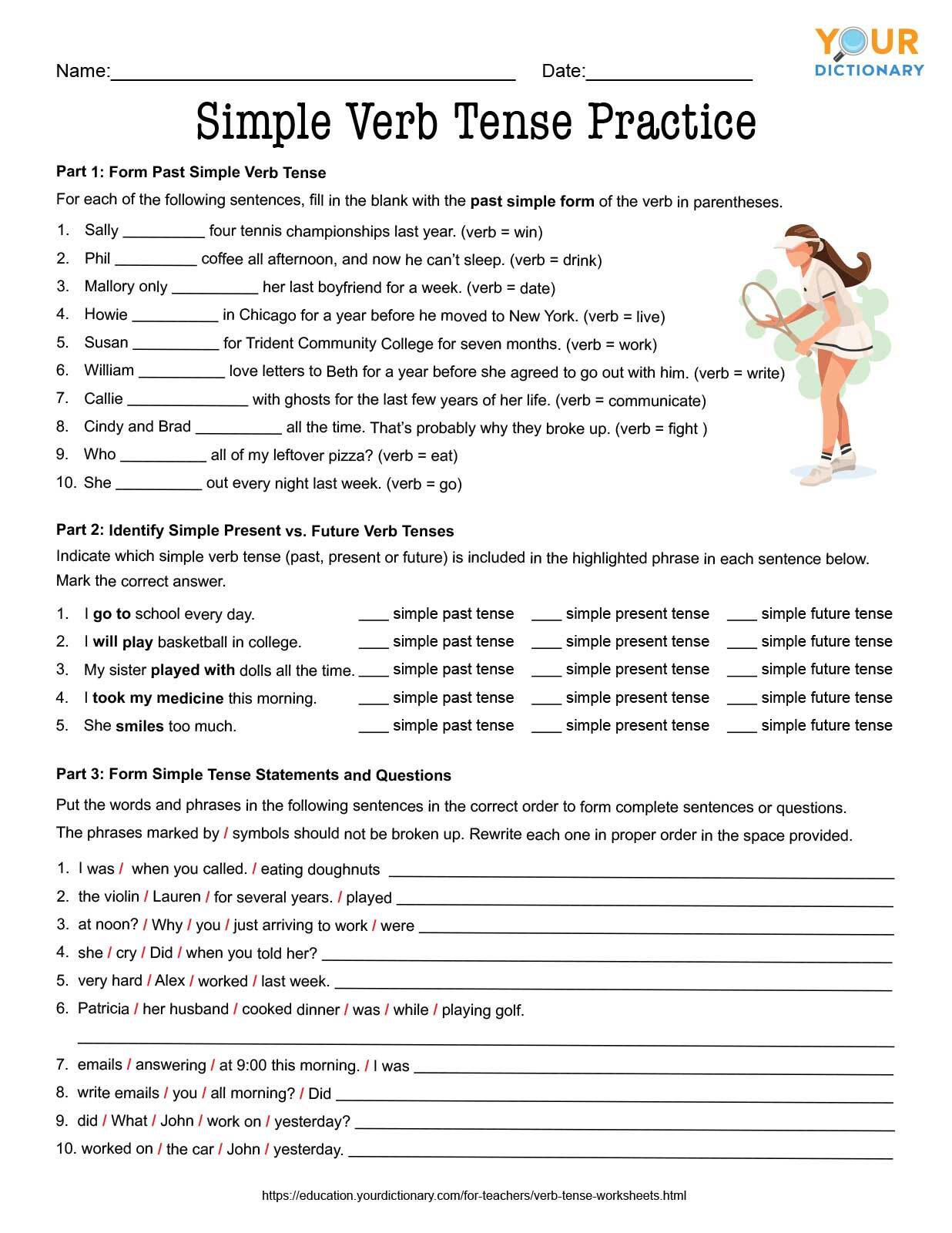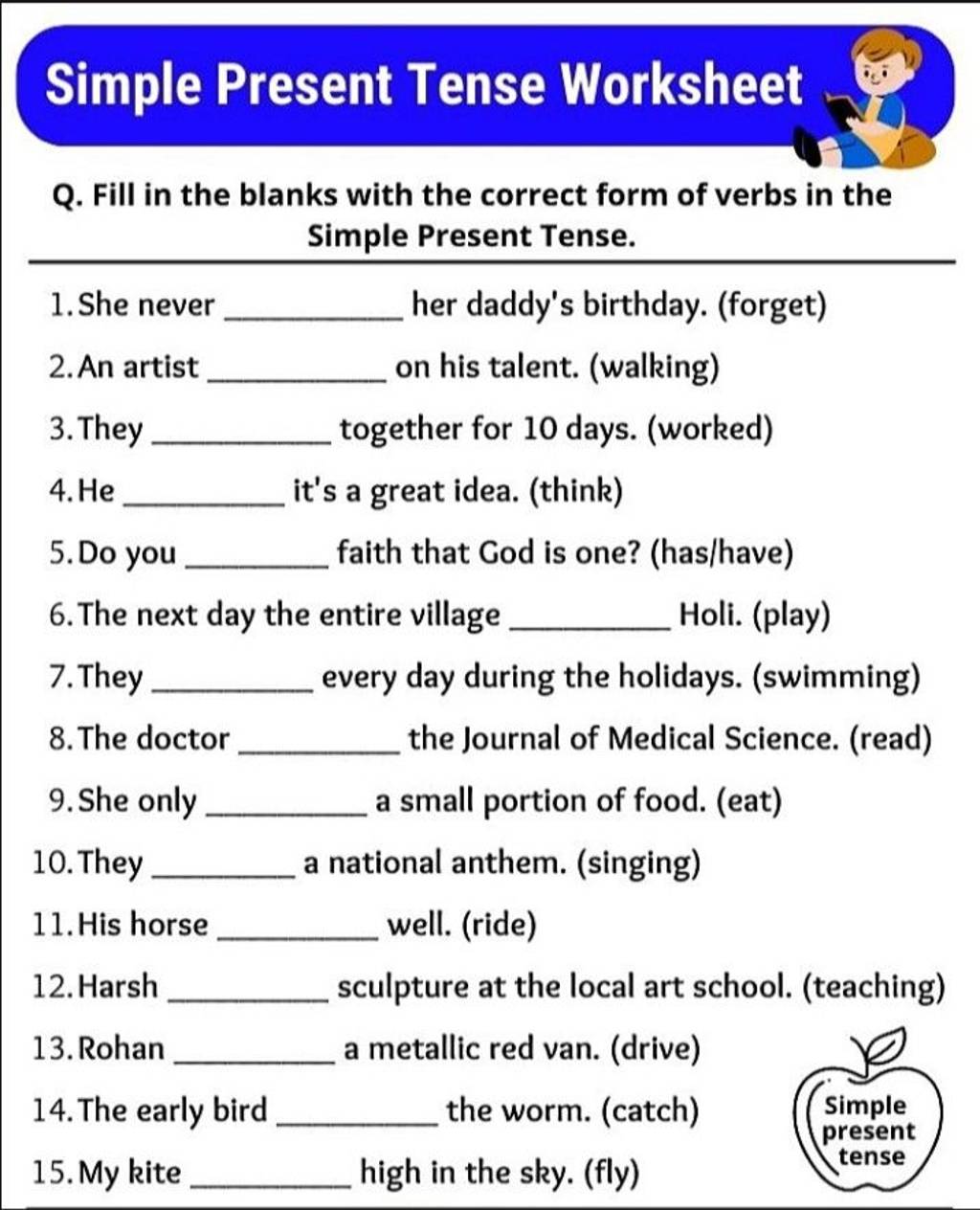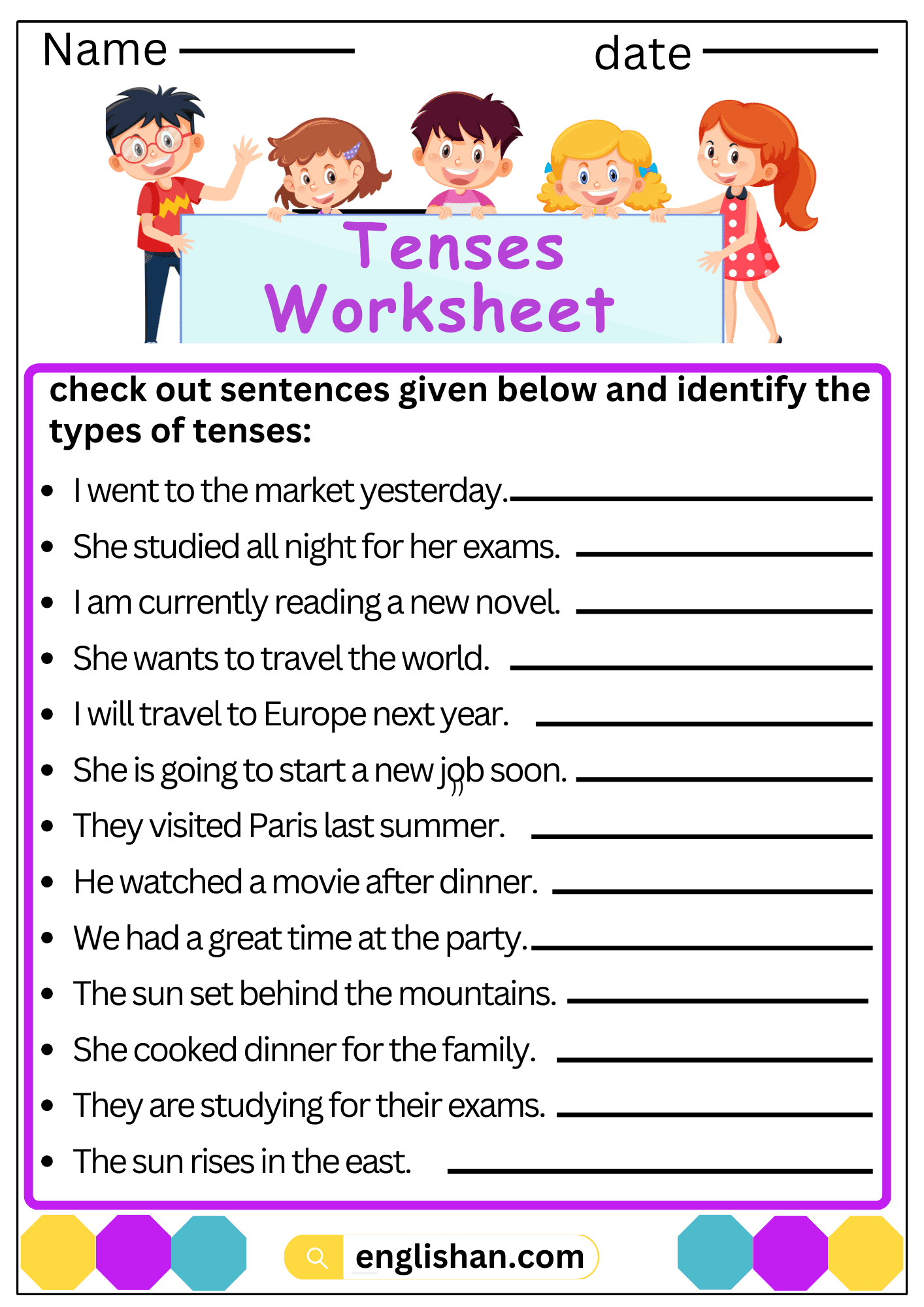
Unlocking English Fluency: A Deep Dive into Effective Tense Worksheets
English, with its rich tapestry of tenses, often presents a formidable challenge for learners worldwide. From the seemingly simple present to the intricate perfect continuous forms, mastering the nuances of time and aspect is crucial for clear and effective communication. While grammar books and explicit instruction lay the theoretical groundwork, it is through consistent practice that true mastery is achieved. This is where tense worksheets emerge as an indispensable tool, serving as the bridge between theoretical understanding and practical application. More than just repetitive drills, well-designed tense worksheets are dynamic learning instruments that solidify comprehension, identify areas for improvement, and build the confidence necessary for fluent expression.
The Indispensable Role of Tense Worksheets in Language Acquisition
The importance of tense worksheets cannot be overstated in the journey of English language acquisition. They offer a structured environment for learners to engage directly with grammatical concepts, moving beyond passive reception of information. Here’s why they are so vital:

- Reinforcement and Retention: After a lesson on, say, the past simple, a worksheet provides immediate opportunities to apply the rules. This active recall strengthens neural pathways, making the information more likely to be retained in long-term memory.
- Identification of Gaps: Errors on worksheets are not failures; they are invaluable diagnostic tools. They pinpoint specific areas where a learner’s understanding is weak or where common misconceptions exist. This allows teachers to tailor subsequent instruction and learners to focus their revision.
- Building Automaticity: Fluency in English isn’t just about knowing the rules; it’s about applying them without conscious effort. Repetitive, yet varied, practice through worksheets helps to automatize the correct formation and usage of tenses, leading to smoother and more natural speech and writing.
- Confidence Building: Successfully completing exercises on a worksheet provides a sense of accomplishment, boosting a learner’s confidence in their ability to grasp complex grammar. This positive reinforcement is crucial for sustained motivation.
- Catering to Different Learning Styles: While some learners thrive on auditory input, others are visual or kinesthetic. Worksheets cater to the visual and kinesthetic learners, allowing them to see the grammar in action and physically interact with the language by writing down answers.




A Spectrum of Tense Worksheets: Variety is Key
Effective tense worksheets are far from one-size-fits-all. They come in a multitude of formats, each designed to target different aspects of tense comprehension and application. A comprehensive approach incorporates a variety of these types:

- Fill-in-the-Blanks: The most common type, where learners insert the correct tense form of a given verb into sentences. These are excellent for initial practice and reinforcing basic conjugation rules.
- Sentence Transformation: Requiring learners to change a sentence from one tense to another (e.g., present simple to past continuous) or from active to passive voice, these exercises deepen understanding of how tense impacts meaning and structure.
- Error Correction: Learners identify and correct grammatical errors related to tenses in given sentences or paragraphs. This sharpens their analytical skills and attention to detail.
- Multiple Choice Questions: Offering several options, these can test nuanced understanding of tense usage in specific contexts, often involving common confusions (e.g., "since" vs. "for" with perfect tenses).
- Matching Exercises: Pairing tense names with example sentences, or time expressions with appropriate tenses, helps reinforce associations and vocabulary related to tense usage.
- Contextualized Paragraphs/Stories: Instead of isolated sentences, learners complete a short story or paragraph by putting verbs into the correct tense. This is crucial for developing an understanding of how tenses work together to convey a sequence of events or ongoing situations.
- Dialogue Completion: Learners fill in the blanks in conversations, requiring them to consider the natural flow of spoken English and the interplay of tenses in real-time communication.
- Creative Writing Prompts: These go beyond simple drills, asking learners to write short narratives or descriptions using specific tenses. For example, "Write about your typical weekend using only the present simple," or "Describe a memorable event from your childhood using the past simple and past continuous." This bridges grammar practice with productive skills.



Crafting and Utilizing Effective Tense Worksheets
The efficacy of tense worksheets lies not just in their existence, but in their thoughtful design and strategic implementation.
For Worksheet Designers/Teachers:
- Clear Instructions: Ambiguity in instructions can hinder learning. Ensure they are concise, easy to understand, and provide examples where necessary.
- Gradual Scaffolding: Start with simpler exercises focusing on a single tense, then progressively introduce more complex tasks that require distinguishing between multiple tenses or using them in integrated contexts.
- Contextualization: Isolated sentences, while useful for initial drills, are limited. Wherever possible, embed sentences within meaningful contexts (e.g., a short story, a description of a routine, a historical account). This helps learners understand when to use a tense, not just how to form it.
- Authenticity: Use language that reflects real-world communication. Avoid overly simplistic or artificial sentences.
- Variety: Mix up the exercise types within a single worksheet or across a series of worksheets to maintain engagement and target different skills.
- Answer Keys: Provide clear, comprehensive answer keys. This facilitates self-correction, which is a powerful learning tool, and allows learners to identify their mistakes immediately.
- Visual Appeal: A well-organized, uncluttered layout with appropriate spacing and clear fonts enhances readability and reduces cognitive load.
- Differentiated Instruction: Design worksheets with varying levels of difficulty to cater to diverse learner needs within a classroom. Some might need more basic reinforcement, while others are ready for advanced challenges.
For Learners:
- Understand Before You Do: Don’t just dive into the exercises. Ensure you understand the rules, common uses, and time expressions associated with the tense being practiced. Refer to your notes or grammar resources.
- Pay Attention to Context: Read the entire sentence or paragraph before filling in a blank. The surrounding words often provide crucial clues about the correct tense.
- Don’t Be Afraid to Make Mistakes: Mistakes are part of the learning process. Use them to understand where your knowledge gaps are.
- Review Your Answers Carefully: After completing a worksheet, use the answer key to correct your work. Don’t just mark it right or wrong; understand why an answer is correct or incorrect.
- Seek Clarification: If you’re unsure about an answer or a rule, ask your teacher or a peer for an explanation.
- Practice Regularly: Consistency is key. Short, regular practice sessions are more effective than infrequent, long ones.
Integrating Tense Worksheets into a Holistic Curriculum
While invaluable, tense worksheets should not exist in isolation. They are most effective when integrated into a broader language learning curriculum that balances explicit grammar instruction with communicative activities.
- Pre-Worksheet Activities: Begin with clear explanations of the target tense, examples, and discussions. Engage learners in activities that activate prior knowledge or introduce the concept in a meaningful way.
- During Worksheet Activities: Encourage collaborative work where appropriate. Pair work on worksheets can foster discussion and peer teaching. Circulate as a teacher, offering guidance and immediate feedback.
- Post-Worksheet Activities: Follow up worksheet completion with communicative tasks that require learners to use the practiced tenses in speaking or writing. This could involve role-plays, debates, presentations, or creative writing assignments. This transition from controlled practice to free production is essential for true fluency.
- Feedback and Remediation: Review common errors from worksheets as a class. Provide targeted feedback to individual learners. Design follow-up activities or mini-lessons to address persistent difficulties.
The Digital Age of Tense Worksheets
The advent of technology has revolutionized the format and accessibility of tense worksheets. While traditional printable worksheets remain highly effective, digital versions offer unique advantages:
- Interactivity: Online worksheets often provide instant feedback, allowing learners to know immediately if their answer is correct. Some platforms even offer hints or explanations for incorrect answers.
- Multimedia Integration: Digital worksheets can incorporate audio and video clips, making the practice more engaging and realistic, especially for listening comprehension related to tense usage.
- Gamification: Many digital platforms transform tense practice into games, complete with points, leaderboards, and badges, significantly boosting learner motivation.
- Accessibility: Learners can access digital worksheets anytime, anywhere, on various devices.
- Tracking Progress: Online learning management systems (LMS) can track a learner’s performance on worksheets, providing valuable data for both the learner and the teacher to monitor progress and identify trends.
However, the simplicity and tangibility of printable worksheets still hold their own. They require no technology, allow for easy annotation, and some learners prefer the act of writing by hand. A balanced approach, utilizing both digital and printable tense worksheets, often yields the best results.
Conclusion
In the complex journey of mastering English tenses, tense worksheets stand out as a foundational pillar. They provide the necessary structure for guided practice, the diagnostic tools for identifying weaknesses, and the repetitive engagement required for building automaticity. From basic fill-in-the-blanks to creative writing prompts, their diverse formats cater to various learning needs and stages. When thoughtfully designed and strategically integrated into a comprehensive curriculum, these invaluable resources empower learners to move beyond theoretical knowledge to confident, accurate, and fluent application of English tenses, truly unlocking their potential for effective communication.
